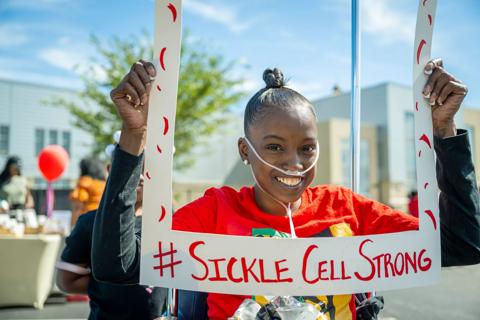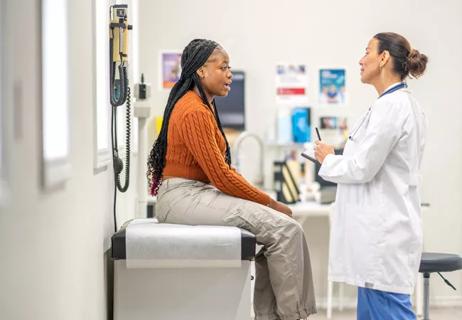Two-year event-free survival comparable to matched sibling donor myeloablative transplant

Reduced-intensity haploidentical bone marrow transplantation (BMT) for sickle cell disease has resulted in durable engraftment with low mortality, according to the Blood and Marrow Transplant Clinical Trials Network (BMT CTN) 1507 study.
Advertisement
Cleveland Clinic is a non-profit academic medical center. Advertising on our site helps support our mission. We do not endorse non-Cleveland Clinic products or services. Policy
Presented at the 2023 American Society of Hematology conference, the findings from the adult cohort of the multicenter, phase 2, prospective trial suggest that haploidentical BMT is an important way to increase the donor pool for patients with sickle cell disease and enable access to this lifesaving therapy. Results from the trial’s pediatric cohort are expected by the end of 2024.
“At two years, the overall post-transplant survival rate for adult patients was 95%, and the event-free survival rate was 88%, which are comparable to the outcomes reported after matched sibling donor myeloablative BMT,” says the study’s co-investigator Rabi Hanna, MD, Chair of the Department of Pediatric Hematology, Oncology and Bone Marrow Transplant at Cleveland Clinic.
Sickle cell disease affects approximately 100,000 U.S. patients, making it the most common hemoglobinopathy in the nation. The event-free survival rate is more than 90% in children with sickle cell disease who undergo myeloablative BMT from a matched sibling donor. However, fewer than 17% of patients with the disease have such a donor, and the myeloablative conditioning (MAC) necessary before BMT can be prohibitively toxic in adults with sickle cell disease, who already may have end-organ damage and may not tolerate the intensity of MAC.
BMT CTN 1507 was launched in 2017, after small studies of reduced-intensity human leukocyte antigen (HLA)-haploidentical BMT with post-transplant cyclophosphamide (PTCy) produced encouraging results. Event-free survival at two years after haploidentical BMT was the primary objective. Secondary objectives included determining the impact on clinical and laboratory manifestations of sickle cell disease and other transplant outcomes at two years.
Advertisement
Over a three-year period, 54 eligible participants ages 15 to 46 were enrolled at 19 sites. Of those, 38 completed the study as planned.
Preconditioning consisted of hydroxyurea 30 mg/kg/day on day -70 to day -10 to suppress the bone marrow. The conditioning regimen consisted of thymoglobulin, thiotepa, fludarabine, cyclophosphamide and total body irradiation. Prophylaxis for graft-versus-host disease (GVHD) included PTCy, sirolimus and mycophenolate.
Of the participants, 59.3% were male, 92.6% were Black and 3.7% were Hispanic. The median age was 22.8 years. Eighty-seven percent had hemoglobin SS disease, 74.1% had a Lansky/Karnofsky score of 90 to 100 at baseline, and 75.9% had an HLA match score of 4 of 8.
The most common indications for transplant were recurrent vaso-occlusive pain episodes (38.9%), acute chest syndrome (16.8%) and overt stroke (16.7%). Only 31% of participants achieved the intended dosing of hydroxyurea preconditioning.
Of the participants, only two had primary graft failure, and one had secondary graft failure before day +100. Cumulative incidence of grades II to IV acute GVHD at day 100 was 26.2% (95% CI: 14.0%-40.2%) — 4.8% for grades III to IV (95% CI: 0.9%-14.4%).
“These results show that a reduced-intensity regimen with thiotepa is very well tolerated, with good rates of engraftment and chimerism and low rates of severe GVHD,” says Dr. Hanna. “The other benefits of this approach are that the technology is well-established, the medication is widely available, and the cost is less than gene therapy, making it accessible to more patients.”
Advertisement
Examining rates of mortality, the investigators noted that two deaths occurred in the first year post-BMT (one due to organ failure and another due to acute respiratory distress syndrome). No deaths occurred in year 2.
“Despite the study’s great outcomes, we still have an approximately 5% mortality rate, and there will be long-term side effects from the chemotherapy,” notes Dr. Hanna. “Ideally we will be able to have a chemotherapy-free or less intense regimen in future studies to enable this life-transformative therapy in more patients.”
Advertisement
Advertisement

Integrated care model reduces length of stay, improves outpatient pain management

New course offers insights into clinical, psychosocial and ethical dimensions of care

Watch for sudden unilateral vision loss without pain

Efficacy, safety and tolerability data shared at hematology meeting

Nurses play key role in comprehensive lifetime treatment program

How to combat the rise in mortality when patients become adults

First-in-human trials of CRISPR-Cas12a gene editing demonstrate safety and meaningful event-free survival

First in-human trial using CRISPR/CASP 12 for gene editing in sickle cell disease